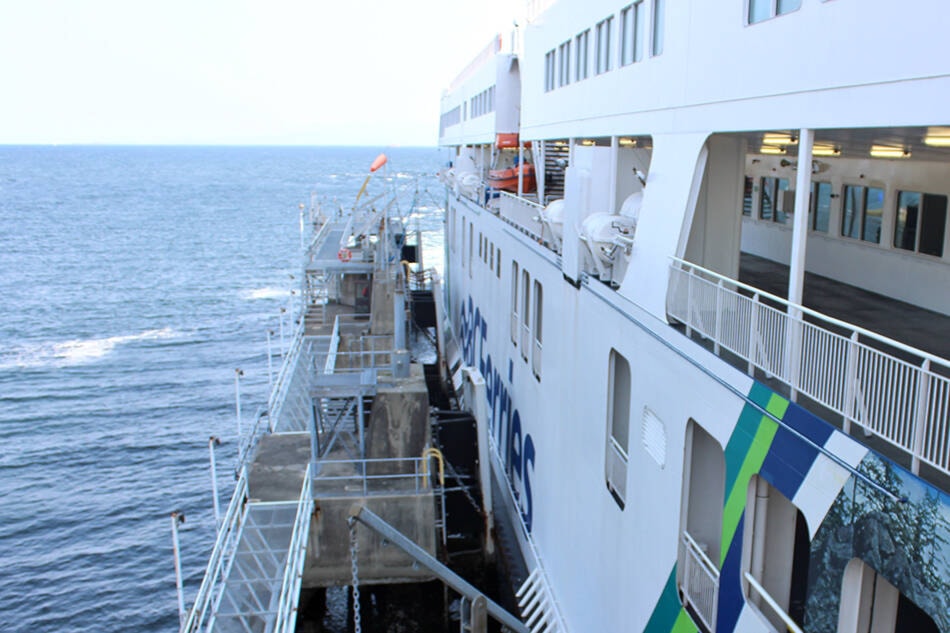With numerous sailing cancellations affecting Nanaimo recently, a local business leader wants a task force in the Harbour City to consult with B.C. Ferries.
Sailing cancellations due to staff shortages have become more common on the Departure Bay-Horseshoe Bay route, with four sailings cancelled Thursday, Aug. 11, and two more Friday, Aug. 12. Kim Smythe, Greater Nanaimo Chamber of Commerce president and CEO, favours a ferry advisory committee, similar to one for Gabriola Island. He said the Departure Bay-Horseshoe Bay route is experiencing a disproportionate number of sailing cancellations, which he called problematic.
“We have no push-back when we get the predominant cancellations in this community and it’s illogical to think that cancellations, or all the crew shortages, are coming from Nanaimo … They’ve been talking about how they’ve hired back 500 people here, or 200 people there, but nothing seems to get any better,” Smythe told the News Bulletin. “Maybe with a new management in place, that’ll change and we’ll see Nanaimo considered differently in the future, but I would really like to see us have a ferry advisory committee here so we could advocate.”
He pointed out that Nanaimo is the only community with three B.C. Ferries terminals.
In an e-mail, Deborah Marshall, B.C. Ferries spokesperson, said 13 ferry advisory committees service ferry-dependent communities along the coast, with none for higher population centres and no plans for more.
B.C.’s largest municipality with a ferry advisory committee is Campbell River, which shares a committee with Quadra and Cortes islands. Some other nearby committees include Brentwood Bay-Mill Bay, Northern Sunshine Coast which includes the Comox-Powell River route, and Southern Sunshine Coast which includes the Horseshoe Bay-Langdale route.
“In large urban areas, we connect with stakeholders in a variety of ways because our customer base is so diverse on major routes,” said Marshall. “We have terminal liaison committees at Departure Bay, Horseshoe Bay and Swartz Bay. We are in regular contact with the B.C. Truckers Association, tourism associations, chambers of commerce and other organizations in our service areas.”
Advisory committees liaise with B.C. Ferries, providing insight on terminal operations, vessel improvements and schedule changes, noted the company’s website. Steve Earle, Gabriola committee chairperson, isn’t sure if it would work for Nanaimo.
“We are a totally ferry-dependent community. Almost everybody uses the ferry several times a month, some people use it five days a week, whereas, say Nanaimo or Vancouver, although people do use the ferry obviously, they’re not really ferry-dependent so the proportion of people in those communities that are really focused on what’s happening on the ferries is small,” said Earle. “That’s why the various ferry advisory committees around the coast are in communities that depend on ferries.”
Eric McNeely, B.C. Ferry and Marine Workers’ Union president, said advisory committees for areas like Nanaimo and Victoria would be advantageous.
“You know, I think there’s always value in getting input from the community and from businesses because both are affected significantly by service levels,” he said.
McNeely said wages have not “kept up with industry” and workers are aging out, when asked about staffing shortages. In addition, requirements have changed.
“In the early ‘90s, if you wanted to be a deckhand or something, you could essentially walk onto a ship with pretty minimal training and get a job,” said the union president. “Now … they’re looking at somewhere in the neighbourhood of $10-14,000 to get that qualification, and [with] their wage, it takes them years to get that money back. So that’s been a challenge and then as you progress in your career, there’s additional layers of training required to Transport Canada, the federal regulator, and there’s cost and time.”
Marshall said B.C. Ferries’ service reliability is approximately 99 per cent, but also recognizes that one cancellation is one too many. In terms of staffing, the company has hired more than 800 employees so far in 2022 and continues to recruit key deck and engineering positions, she said. B.C. Ferries has announced signing and retention payments, incentives for seasonal employees and training opportunities for workers, and recruitment is continuing.
Earle said he is satisfied with level of communication from B.C. Ferries. The company tries to give advance warning for cancellations, he said.
“Over the past four to five months, there’s been maybe three times when it’s been cancelled, but that’s involved many runs, so for most of a day one ferry was out of operation. It hasn’t been too frequent and has not been a huge inconvenience to the community,” he said.
Marshall added that B.C. Ferries always welcomes feedback from people about its service.
RELATED: B.C. Ferries CEO fired
RELATED: Gabriola ferries on time, with fewer waits: B.C. Ferries
reporter@nanaimobulletin.com
Like us on Facebook and follow us on Twitter
